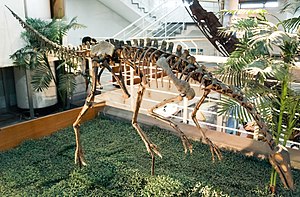Archaeornithomimus
| Archaeornithomimus | ||||||||||||
|---|---|---|---|---|---|---|---|---|---|---|---|---|

Skeleton replica of Archaeornithomimus |
||||||||||||
| Temporal occurrence | ||||||||||||
| Upper Cretaceous ( Coniacium ) | ||||||||||||
| 89.7 to 86.3 million years | ||||||||||||
| Locations | ||||||||||||
| Systematics | ||||||||||||
|
||||||||||||
| Scientific name | ||||||||||||
| Archaeornithomimus | ||||||||||||
| Russell , 1972 |
Archaeornithomimus is a genus of dinosaurs from the group of Ornithomimosauria within the Theropoda . He lived in the early Upper Cretaceous in what is now East Asia.
features
Archaeornithomimus reached a length of around 3.5 meters. Its physique resembled that of the other Ornithomimidae : the relatively small and lightly built skull sat on a long, flexible neck. The snout was elongated and ended in a horned beak, teeth were absent. The big eyes sat on the side of the head. The arms were relatively large, but weakly built. The hands carried three fingers that ended in blunt claws. The hind legs were larger than the front legs, the dinosaur moved biped (on two legs). The elongated lower legs and metatarsals are an indication that Archaeornithomimus was able to walk quickly. The feet ended in three toes pointing forward. Other ornithomimidae this dinosaur was different in the more robust limb bones, in the number of sacral vertebrae (five instead of six sacral vertebrae) and in the construction of the ischium (ischium).
Archaeornithomimus is one of the few ornithomimosaurs from which a mass deposit of many, sometimes poorly preserved, animals has been found. It is therefore conceivable that he lived in groups for at least part of the year. What this dinosaur ate with its toothless beak is not known. Findings in related genera tend to suggest a herbivorous or omnivorous diet.
Discovery and naming
The fossil remains of Archaeornithomimus were found in the Iren Dabasu Formation in Inner Mongolia , China . In 1933 it was first described by Charles W. Gilmore , still under the name Ornithomimus asiaticus - it was the first representative of this group to be discovered in Asia. In 1972 Dale Alan Russell coined the new genus Archaeornithomimus . The name ("old bird imitator") alludes to the similarity with the "bird imitator" Ornithomimus and to the older age of this find. Information on the age of this dinosaur varies, Makovicky et al. (2004) date the find provisionally in the Coniacium (early Upper Cretaceous, approx. 89 to 86 million years ago).
literature
- Peter J. Makovicky , Yoshitsugu Kobayashi, Philip J. Currie : Ornithomimosauria. In: David B. Weishampel , Peter Dodson , Halszka Osmólska (eds.): The Dinosauria . 2nd edition. University of California Press, Berkeley CA et al. 2004, ISBN 0-520-24209-2 , pp. 137-150.